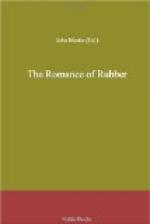Less than twenty years ago Brazil produced practically all the rubber used in the world. But to-day she furnishes less than one-tenth of the world’s supply. How Brazil, possessing in her vast forests millions of rubber trees of the finest quality, has been forced by unfavorable conditions to permit the Far East to sweep from her in this short time the crude rubber supremacy of the world is one of the most unusual chapters in modern industrial history.
CHAPTER 4
WICKHAM’S IDEA
The story of the success of the East Indies in wresting the crude rubber supremacy from Brazil, begins with an Englishman named Wickham, who might be called the father of plantation rubber.
Wickham, who had spent some years in South America, understood the difficulties of gathering rubber in the jungles. He believed that if rubber could be cultivated it might prove a good crop on the coffee plantations in India which a blight had recently rendered valueless for coffee. What a strange fact it is that this blight gave Brazil a chance to go into coffee growing, and that while Brazil was losing the rubber supremacy to the Far East, the Far East at about the same time was surrendering the leadership in coffee to Brazil. The latter now holds first place in coffee growing as firmly as does the Far East in rubber growing.
Wickham saw that there were difficulties that would prevent the gathering of wild rubber from keeping pace with the growing demand. Although millions of rubber trees still stood untouched in the Brazilian forests, only those trees near the river banks could be tapped because of the impossibility of getting the rubber out of the dense vegetation. Life in the jungle was dangerous and lonely, and therefore rubber gatherers were not easy to find. They were compelled to work far from their families and friends, and in constant danger from wild beasts, reptiles and death-bearing fevers. It is no wonder that rubber obtained in this way came to be known as “wild rubber.” Moreover, transporting the crude product through the jungles was hard and expensive and the rubber obtained under these conditions was not always so clean or high in quality as might be wished.
“If rubber trees grow from the seeds which nature scatters in the jungle,” said Wickham to himself, “why should they not grow from seeds put into the ground by hand?”
“If rubber trees could be raised from seed, they could be planted in the open in rows where they could easily be tended and tapped, and the rubber gathered quickly and safely. Instead of having to brave the dangerous jungles, men could plant and cultivate rubber in spots of their own choosing so long as they chose places where the climate was right.”




